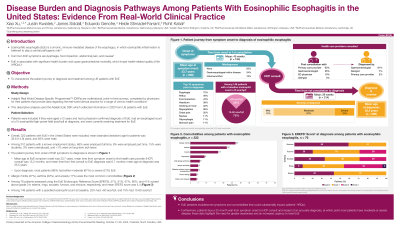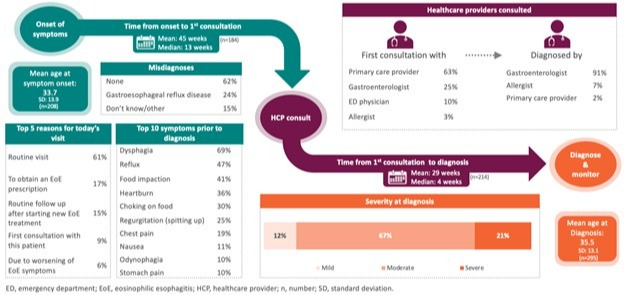Back


Poster Session B - Monday Morning
Category: Esophagus
B0198 - Disease Burden and Diagnosis Pathways Among Patients With EoE in the United States: Evidence From Real World Clinical Practice
Monday, October 24, 2022
10:00 AM – 12:00 PM ET
Location: Crown Ballroom

Has Audio
- XX
Xiao Xu, PhD
AstraZeneca
Gaithersburg, MD
Presenting Author(s)
Xiao Xu, PhD1, Justin Kwiatek, PharmD1, James Siddall, 2, Eduardo Genofre, MD, PhD3, Heide Stirnadel-Farrant, PhD4, Rohit Katial, MD1
1AstraZeneca, Gaithersburg, MD; 2Adelphi Real World, Cheshire, England, United Kingdom; 3BioPharmaceuticals US Medical Affairs, AstraZeneca, Wilmington, DE; 4AstraZeneca, Cambridge, England, United Kingdom
Introduction: Eosinophilic esophagitis (EoE), which is a chronic immune-mediated inflammatory disorder of the esophagus, is one of several heterogeneous inflammatory conditions, known as eosinophil-associated diseases (EADs). Common EoE symptoms are dysphagia, food impaction, abdominal pain, and nausea. EoE is associated with significant burden and upper gastrointestinal morbidity that impair health-related quality of life (HRQoL). This real-world study characterizes the patient journey to diagnosis and treatment among US patients with EoE.
Methods: Adelphi Real World Disease Specific Programmes (DSPs) are multinational, point-in-time surveys, completed by physicians for their patients, which provide data regarding the real-world clinical practice for a range of chronic health conditions. This study used the Adelphi EoE DSP, which collected information in 2020 from US patients with EoE. Eligible patients were ≥12 years with a physician-confirmed EoE diagnosis, an esophageal count of ≥15 eosinophils (EOS)/high-power field (HPF) at diagnosis, and were currently prescribed treatment for EoE.
Results: Overall, 322 patients with EoE were included in the United States. Mean patient age was 35.6 years and mean body mass index was 25.4. Most patients (63%) were male, 74% were employed full/part time, 15% were students, 3% were on leave/unemployed, and 3% needed caregiver support due to EoE. Most frequent EoE symptoms prior to diagnosis are shown in the Figure. Mean age at EoE symptom onset was 33.7 years, mean time from symptom onset to first healthcare provider (HCP) consult was 15.2 months, and from first consult to EoE diagnosis was 6.7 months; mean age at diagnosis was 35.5 years. Most patients (88%) were diagnosed with either moderate (67%) or severe (21%) EoE; among those assessed using EREFS (n=76), 57%, 91%, 67%, 80%, and 41% scored above Grade 0 in edema, rings, exudate, furrows, and stricture, respectively. Among 52 patients with a recent esophageal count, 77% (n=40) still had a count of ≥15 EOS/HPF after a mean 28 months since diagnosis and on treatment, although only 28% (n=11) of those patients were considered moderate/severe EoE cases. Allergic rhinitis (27%), asthma (22%), and anxiety (17%) were the most common comorbidities.
Discussion: EoE presents severe symptoms and comorbidities that could substantially impact patients’ HRQoL. Furthermore, patients faced 22 months of wait from symptom onset to HCP consult and receipt of an accurate diagnosis.

Disclosures:
Xiao Xu, PhD1, Justin Kwiatek, PharmD1, James Siddall, 2, Eduardo Genofre, MD, PhD3, Heide Stirnadel-Farrant, PhD4, Rohit Katial, MD1. B0198 - Disease Burden and Diagnosis Pathways Among Patients With EoE in the United States: Evidence From Real World Clinical Practice, ACG 2022 Annual Scientific Meeting Abstracts. Charlotte, NC: American College of Gastroenterology.
1AstraZeneca, Gaithersburg, MD; 2Adelphi Real World, Cheshire, England, United Kingdom; 3BioPharmaceuticals US Medical Affairs, AstraZeneca, Wilmington, DE; 4AstraZeneca, Cambridge, England, United Kingdom
Introduction: Eosinophilic esophagitis (EoE), which is a chronic immune-mediated inflammatory disorder of the esophagus, is one of several heterogeneous inflammatory conditions, known as eosinophil-associated diseases (EADs). Common EoE symptoms are dysphagia, food impaction, abdominal pain, and nausea. EoE is associated with significant burden and upper gastrointestinal morbidity that impair health-related quality of life (HRQoL). This real-world study characterizes the patient journey to diagnosis and treatment among US patients with EoE.
Methods: Adelphi Real World Disease Specific Programmes (DSPs) are multinational, point-in-time surveys, completed by physicians for their patients, which provide data regarding the real-world clinical practice for a range of chronic health conditions. This study used the Adelphi EoE DSP, which collected information in 2020 from US patients with EoE. Eligible patients were ≥12 years with a physician-confirmed EoE diagnosis, an esophageal count of ≥15 eosinophils (EOS)/high-power field (HPF) at diagnosis, and were currently prescribed treatment for EoE.
Results: Overall, 322 patients with EoE were included in the United States. Mean patient age was 35.6 years and mean body mass index was 25.4. Most patients (63%) were male, 74% were employed full/part time, 15% were students, 3% were on leave/unemployed, and 3% needed caregiver support due to EoE. Most frequent EoE symptoms prior to diagnosis are shown in the Figure. Mean age at EoE symptom onset was 33.7 years, mean time from symptom onset to first healthcare provider (HCP) consult was 15.2 months, and from first consult to EoE diagnosis was 6.7 months; mean age at diagnosis was 35.5 years. Most patients (88%) were diagnosed with either moderate (67%) or severe (21%) EoE; among those assessed using EREFS (n=76), 57%, 91%, 67%, 80%, and 41% scored above Grade 0 in edema, rings, exudate, furrows, and stricture, respectively. Among 52 patients with a recent esophageal count, 77% (n=40) still had a count of ≥15 EOS/HPF after a mean 28 months since diagnosis and on treatment, although only 28% (n=11) of those patients were considered moderate/severe EoE cases. Allergic rhinitis (27%), asthma (22%), and anxiety (17%) were the most common comorbidities.
Discussion: EoE presents severe symptoms and comorbidities that could substantially impact patients’ HRQoL. Furthermore, patients faced 22 months of wait from symptom onset to HCP consult and receipt of an accurate diagnosis.

Figure: Figure
Disclosures:
Xiao Xu: AstraZeneca – Employee, Stock-publicly held company(excluding mutual/index funds).
Justin Kwiatek: AstraZeneca – Employee, Stock-publicly held company(excluding mutual/index funds).
James Siddall: Adelphi Real World – Employee, Grant/Research Support.
Eduardo Genofre: AstraZeneca – Employee, Stock-publicly held company(excluding mutual/index funds).
Heide Stirnadel-Farrant: AstraZeneca – Employee, Stock-publicly held company(excluding mutual/index funds).
Rohit Katial: AstraZeneca – Employee, Stock-publicly held company(excluding mutual/index funds).
Xiao Xu, PhD1, Justin Kwiatek, PharmD1, James Siddall, 2, Eduardo Genofre, MD, PhD3, Heide Stirnadel-Farrant, PhD4, Rohit Katial, MD1. B0198 - Disease Burden and Diagnosis Pathways Among Patients With EoE in the United States: Evidence From Real World Clinical Practice, ACG 2022 Annual Scientific Meeting Abstracts. Charlotte, NC: American College of Gastroenterology.
